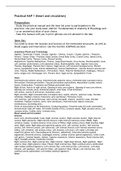Class notes
Practical manual Anatomy (HAP) 1
- Course
- Institution
In this document, you can find the Anatomy manual for the course Human Anatomy and Physiology. This included questions and answers about what you learn during the practicals and may be very useful while studying for the exam. Some answers are written a bit longer in order to give extra information ...
[Show more]



